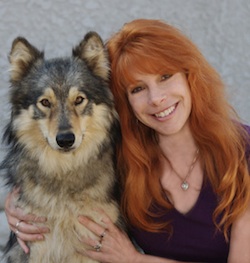| Back to Back Issues Page |
 |
|
The Yes Dog!, Issue #003 -- Can you recognize fear in dogs? February 15, 2013 |
Issue #003, February 15th 2013Welcome to the Third issue of The Yes Dog! I am so excited to share with you some of the new articles in our website. And a little bit of science as well! (it never hurts)... Feel free to drop me a line with questions, suggestions or even a theme you would like to see featured here. You can send me a quick
e-mail!
Happy Valentine's Day to Everyone! Did you do something special for your hound? maybe a special home-made treat or a fun training session learning tricks? In this issue you will learn a little bit about fear in dogs. This is an important topic because I don't want anyone thinking their dog is barking to be dominant! Most dogs show signs of aggression because they are afraid or because they are stressed. Your task is to learn to recognize emotions in your furry best friend. From joy to fear know what your pet is feeling. Like the quote below says, become a little bit dog yourself.
Table of Contents
The Science of Dog TrainingYour ability to recognize fear in dogs increases with experience.A Review of Wan M., Bolger N., Champagne FA. Human Perception of Fear in Dogs Varies According to Experience with Dogs. PLOS One, December 2012.Do you know what your dog is feeling? What do you pay attention to when trying to understand your hound better? His vocal signals? or is it something visual that calls your attention? Many scientists have asked those questions and conclude that we can use both auditory (barks or other vocalizations) and visual (body postures) signals to interpret our canines emotions. What seems to be interesting is the fact that to understand canine body language, experience gives you a definite advantage. A study published last year by Kujala and colleagues asked human participants to view images of dogs while their brains were being analyzed by fMRI. They found evidence suggesting that people with lots of experience with dogs used similar brain structures and patters of mental activity to interpret body postures from dogs and humans. People without dog experience used different brain activity patters for these interpretations. It's almost like the experienced dog people were more in tune with dogs. They thought of them as they think about humans. The quote in the Valentine's day picture keeps coming to my mind! Wan and colleagues set out to better test this idea that experience dog handlers are better at understanding dog's emotions by attending to body language. According to the authors the most common emotion categories are: anger, fear, happiness, sadness, disgust and surprise. They chose to analyze the first 4 because there is scientific evidence that hounds are able to feel these kinds of emotional states.
How did they test this? They created a questionnaire, the participants had to watch several videos of different dog behaviors. They then had to choose in which of the 4 categories did the video fit (happy, sad, fear, anger) and what did they pay attention to when coming up with their answer (ears, mouth/tongue, eyes, tail, legs/paws). They compiled data from 2,163 participants. What was their finding? Experienced dog handlers were much better at recognizing fear in dogs. Most participants were able to recognize happiness. How did these two groups of people differ from each other? The experienced group payed attention to more body features than the inexperienced group. Eyes, ears and mouth were most often overlooked by inexperienced participants. So, now you know! Pay attention to all of your furry friend's signals! You can read the articles on our website about dog body language, they are full of pictures to help you understand what to look for.
Did you know that yawning at inappropriate times or too often could be a signal of stress in your dog? There is a group is this body postures called "Calming Signals" which dogs often use to calm themselves and other dogs or people around them.
For a challenge... You can see two of the videos used for this research article. Can you recognize fear vs. happiness? Human Perception of Fear in Dogs Varies According to Experience with Dogs. If you follow this link it will take you to the "supporting information" part of the research article. You can then scroll down until you see Video S1 and Video S2. You have to download the videos to watch them. See if you can recognize the dog's emotions!
What is your dog telling you with his/her body language? Upload a picture and share it with us! References: Human Perception of Fear in Dogs Varies According to Experience with Dogs. Wan M., Bolger N., Champagne FA. PLOS One, December 2012. Train your dog to...Ask for Permission!
Wouldn't you love if your dog would ask for permission before doing anything? Then you would have the chance to prevent him from running after a squirrel or rolling in poop... It can be done! It requires a lot of practice, patience and consistency as usual. You will use the dog training method Capturing. This means that you will wait for your hound to pay attention to you before letting him to something. There are 3 key exercises in this article to start you with. After many repetitions you will be able to move on to other things until your pooch "gets it". This is technically not a command, but something your pet should do every time he wants to do something.
To learn these exercises in training a reliable "Ask for permission" follow this link. Featured ArticleHelp your fearful dog - Learn how to stop dog barking in fearful and stressed hounds
If you have a barking problem with your dog, is it because he is afraid and stressed? Never use punishment to solve a barking problem. Specially if you have a fearful dog. This could make things even worse! We talked about recognizing fearful signs in your pet. Make sure you become very proficient at this! It will be key to training. To help a fearful dog, you will need to learn about Systematic desensitization and Counterconditioning. They are long words, but techniques easy enough to implement. The whole idea is to go very slowly and use plenty of rewards for not barking or growling. Learn here what to do and what not to do to stop your fearful hound barking. Interviews with Pet ExpertsNicole Wilde, Author and Canine Behavior Specialist
Nicole Wilde has written several dog behavior and training books. She is internationally recognized for her expertise in both dogs and wolves. Nicole is a positive dog trainer and we were lucky to have her spend some time answering Dog Training Excellence questions. Sneak Peak:"Probably the most obviously "wolfish" characteristics we see in dogs is prey drive. The difference is that while wolves have the entire sequence--search, eye-stalk, chase, grab, bite, kill--our dogs have truncated sequences."
Get advice, tips and insight from this interview! You don't want to miss it. Your Questions and StoriesThis section is for you to brag about your dog! You can also ask questions (and get answers), tell us your advice or share an interesting anecdote. Your story could be featured in The Yes Dog! And will get its own webpage that you can share with friends and family. Click here to share! This issue's featured story is about Lambchop. The cutest little dog that can tease you to approach only to snap!
Click here to add your comments to this story! That is all for now. Until the next time,
P.S: Would you like to have your own website? It is easier than you think. I had no knowledge about the web but here I am! You can have yours too... watch the Site Build It! Video Tour. 
Copyright © 2012-2013 Natalia Rozas de O'Laughlin. All Rights Reserved. Unauthorized duplication or publication of any materials prohibited. Not intended to substitute for veterinary, legal or other professional advice. Consult your vet for advice about medical or behavioral conditions & treatment of your pet. Thank you 123rf.com for some of the pictures featured in The Yes Dog! |
| Back to Back Issues Page |




